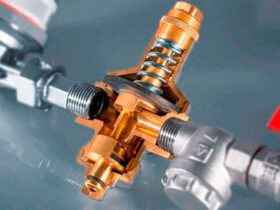From the moment the Toppa septic tank appears on the market, the issue with the organization of autonomous sewage system may be closed. Innovative development allows you to clean the drains (sewage and domestic) biological method, bringing contaminated water to a state in which it is safe for ecology. Now in any suburban area, cottage, in the cottage, an effective and safe for nature and humans autonomous sewage system — septic tank is installed.
Depending on the model, the installation and connection of the Toppa septic tank can be carried out by a team of workers without the use of heavy equipment, or with its participation. For example, Topas 5 or Topas 8 models are mounted and launched without special equipment with a brigade of 4 people.
Pokilvan preparation, station installation and falling asleep
Preparation of a pit for installing a septic tank and trenches for laying pipes is the first stage of installation. To ensure safety during installation of a septic tank, especially if groundwater is close to the surface, to prevent the soil shower, the foundation pit must be equipped with formwork from the boards. To align the base, the bottom of the pit is covered with sand, and the thickness of the sand cushion should be such that the cover of the already installed structure is located above the soil level by 20 cm.
After the boiler for the septic tank is ready, you can proceed to the installation of the station in it. Household models, the installation of which does not require special equipment, are equipped with special holes in stiffeners, through which you can skim cords for a more convenient and smooth installation of the station case. This procedure can manually carry out 4 people, but their task is not only a gentle and careful installation of a septic tank in a pit, but also aligning it in horizon.
Then it is required to fall asleep the pit in which the septic tank is installed, sand to a height of 50 cm. At the same time, the station capacity is filled with water. These manipulations are performed synchronously to compensate for pressure in the septic tank body from the outside and from the inside.
Pipe specification
After that, they proceed to laying the supply pipes in already prepared trenches. Communications are brought to a septic tank with a slope of 2 cm per 1 meter of the laid track. The septic tank can accumulate and clean the wastewater and sewer from several objects. For example, you can bring pipes from a residential building, a bath or sauna, a guard house, a temporary aid to bring it to it. In such cases, the inspection and installation of each pipe is carried out separately. As a rule, at the stage of laying and installation of communications, PND pipes with a diameter of 110 mm are used: they do not need to strengthen or warm.
If the track from a residential facility to a septic tank is more than 15 meters, each 10 meters should be installed by revision wells, which are also arranged at each bend when laying communications.
Toppar connection
In order to carry out the installation of the supply pipe to the station case, a hole of the corresponding diameter is cut out in it. The pipe of the pipe is produced by polypropylene, which ensures the tightness of the seam. The installation location (or place, if several pipes are brought to the septic tank) is determined in specific conditions, therefore, the levels of the station are not initially provided for the installation of pipes. The sewage device in the cottage also has its own characteristics.
At the final stage, the electric cable is laid and connect to the installation. The cable, as a rule, fits in the same trench as the supply pipe. The technical passport attached to the station indicates a detailed septic tank connection scheme to the power source. At the same time, you can mount compressor equipment.
On this installation, installation and connection of Toppa septic tank is considered completed, and the station is ready to perform its functions.
From the moment the Toppa septic tank appears on the market, the issue with the organization of autonomous sewage system may be closed. Innovative development allows you to clean the drains (sewage and domestic) biological method, bringing contaminated water to a state in which it is safe for ecology. Now in any suburban area, cottage, in the cottage, an effective and safe for nature and humans autonomous sewage system — septic tank is installed.
Depending on the model, the installation and connection of the Toppa septic tank can be carried out by a team of workers without the use of heavy equipment, or with its participation. For example, Topas 5 or Topas 8 models are mounted and launched without special equipment with a brigade of 4 people.
Pokilvan preparation, station installation and falling asleep
Preparation of a pit for installing a septic tank and trenches for laying pipes is the first stage of installation. To ensure safety during installation of a septic tank, especially if groundwater is close to the surface, to prevent the soil shower, the foundation pit must be equipped with formwork from the boards. To align the base, the bottom of the pit is covered with sand, and the thickness of the sand cushion should be such that the cover of the already installed structure is located above the soil level by 20 cm.
After the boiler for the septic tank is ready, you can proceed to the installation of the station in it. Household models, the installation of which does not require special equipment, are equipped with special holes in stiffeners, through which you can skim cords for a more convenient and smooth installation of the station case. This procedure can manually carry out 4 people, but their task is not only a gentle and careful installation of a septic tank in a pit, but also aligning it in horizon.
Then it is required to fall asleep the pit in which the septic tank is installed, with sand to a height of 50 cm. At the same time, the station capacity is filled with water. These manipulations are performed synchronously to compensate for pressure in the septic tank body from the outside and from the inside.
Pipe specification
After that, they proceed to laying the supply pipes in already prepared trenches. Communications are brought to a septic tank with a slope of 2 cm per 1 meter of the laid track. The septic tank can accumulate and clean the wastewater and sewer from several objects. For example, you can bring pipes from a residential building, a bath or sauna, a guard house, a temporary aid to bring it to it. In such cases, the inspection and installation of each pipe is carried out separately. As a rule, at the stage of laying and installation of communications, PND pipes with a diameter of 110 mm are used: they do not need to strengthen or warm.
If the track from a residential facility to a septic tank is more than 15 meters, each 10 meters should be installed by revision wells, which are also arranged at each bend when laying communications.
Toppar connection
In order to carry out the installation of the supply pipe to the station case, a hole of the corresponding diameter is cut out in it. The pipe of the pipe is produced by polypropylene, which ensures the tightness of the seam. The installation location (or place, if several pipes are brought to the septic tank) is determined in specific conditions, therefore, the levels of the station are not initially provided for the installation of pipes. The sewage device in the cottage also has its own characteristics.
At the final stage, the electric cable is laid and connect to the installation. The cable, as a rule, fits in the same trench as the supply pipe. The technical passport attached to the station indicates a detailed septic tank connection scheme to the power source. At the same time, you can mount compressor equipment.
On this installation, installation and connection of Toppa septic tank is considered completed, and the station is ready to perform its functions.












Оставить коммент.